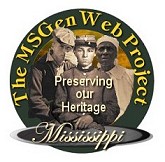
Pontotoc County, Mississippi
Genealogy and History
Peggy A. Young, County CoordinatorJeff Kemp - State Coordinator Denise Wells - Assistant State Coordinator
Ann Allen Geoghegan - Assistant State Coordinator
Sunday, 13-Jun-2010 13:43:55 EDT

W. P. A. History of Pontotoc County, Mississippi
CHAPTER 1 CONTINUED
Interviews
MRS. MATTIE HENDERSON, daughter of J. C. and Margaret Shelton Richie, who came from South Carolina over the Natchez Trace in the late 1830s in search of a location for themselves and their South Carolina friends, recalls what her father told her of landmarks along the Natchez Trace:
"The Chickasaw Council House was on a hill two miles south of Whitworth's store, three miles south of Pontotoc. A pine tree was left standing for years in and old field on the Dewey Stacy place, known as the John Grisham old place, because it was a trading and parleying place for whites and Indians. The Indians were friendly and helpful unless enraged by mistreatment, then they were treacherous and resentful. Margaret Richie, wife of J. C. Richie, said there were a number of large trees a short distance west of the present Pontotoc Okolona Road, five miles south of Pontotoc, where squaws came to beg and to sell woven baskets.
When "Grandfather" Shelton came from Alabama with his family in the fall of the year, there was a trading station on the land, which lager became the Pinson Place. He entered land on Coonewah Creek at the land office in Pontotoc.
Settler came slowly through a dense wilderness, first on foot, then on horseback, and later in ox-wagons. There were no roads or bridges, so travelers kept to the ridges and crossed streams where they were most easily forded. However there was much to encourage the settlers; the stock did not have to be fed during the winter because usually the rains were so plentiful that wild pea vines, grasses, and cane were abundant; there were nuts, acorns, and roots for hogs; the streams were deep and supplied fish; and there was also game of all kinds - deer, turkey, coon, opossum, and squirrel.
The land along Chiwapa was fertile and produced as high as fifty bushels of wheat and seventy-five bushels of corn per acre. This cotton was most often seeded by hand, after which it was spun and woven into cloth for slaves' use. The markets were Memphis and Mobile.
When land-buyers came through the wilderness trails there were no robberies. Many of the prospectors stayed at the home of J. C. Richie on the way to the prairie section, and at night would place their saddle-pockets in his care.
When land officer were opened at Pontotoc, buyers came and scattered throughout the county. Reverend Robert Bonner, Methodist minister, a Mr. Cameron, Judge Pinson, the Woods, Garretts, and Grishams were among the earlier ones. All of them brought slaves. Millions of feet of valuable timber were cut and burned in the clearing of land. While the "bottoms" were being cleared there were terrible scourges of fatal sickness from June until frost. Patients were treated by sweat baths, bleeding, and by herb and bark teas. Pioneer homes built of hewn logs by Slave labor; dug wells and springs supplied water. Wealthy plantation children were taught by governesses but other children had few school advantages until the free school system was adopted. Mrs. Henderson says the first school that she remembers was taught by Miss Mary Landers.
Horseback riding, quiltings, small social gatherings, dances, and religious meetings furnished amusement and social intercourse. However there was not so much dancing in and around this settlement, as the religious folk were too strict for it and the church condemned it. The majority of the people, for the same reason, rarely cooked on Sunday.
Horses and Mules were brought in droves from Tennessee and Kentucky, so there were many fine animals in the settlement. Horse stealing became a menace; a chain of thieves extended from the Mississippi River, via the Tallahatchie on to the prairie. (1)
(1) Mrs. Mattie Henderson, Pontotoc, Miss.
Photograph: Council Hill
Back Contents Next